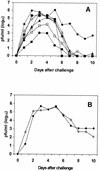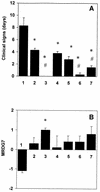Protective antiviral immune responses to pseudorabies virus induced by DNA vaccination using dimethyldioctadecylammonium bromide as an adjuvant
- PMID: 12239334
- PMCID: PMC136542
- DOI: 10.1128/jvi.76.20.10540-10545.2002
Protective antiviral immune responses to pseudorabies virus induced by DNA vaccination using dimethyldioctadecylammonium bromide as an adjuvant
Abstract
To enhance the efficacy of a DNA vaccine against pseudorabies virus (PRV), we evaluated the adjuvant properties of plasmids coding for gamma interferon or interleukin-12, of CpG immunostimulatory motifs, and of the conventional adjuvants dimethyldioctadecylammonium bromide in water (DDA) and sulfolipo-cyclodextrin in squalene in water. We demonstrate that a DNA vaccine combined with DDA, but not with the other adjuvants, induced significantly stronger immune responses than plasmid vaccination alone. Moreover, pigs vaccinated in the presence of DDA were protected against clinical disease and shed significantly less PRV after challenge infection. This is the first study to demonstrate that DDA, a conventional adjuvant, enhances DNA vaccine-induced antiviral immunity.
Figures






Similar articles
-
Cytokine GM-CSF genetic adjuvant facilitates prophylactic DNA vaccine against pseudorabies virus through enhanced immune responses.Microbiol Immunol. 2006;50(2):83-92. doi: 10.1111/j.1348-0421.2006.tb03773.x. Microbiol Immunol. 2006. PMID: 16490926
-
A DNA vaccine coding for gB and gD of pseudorabies virus (suid herpes type 1) primes the immune system in the presence of maternal immunity more efficiently than conventional vaccines.Vaccine. 2006 Feb 27;24(9):1264-73. doi: 10.1016/j.vaccine.2005.09.041. Epub 2005 Oct 3. Vaccine. 2006. PMID: 16289276
-
Vaccination with the glycoprotein D gene of pseudorabies virus delivered by nonpathogenic Escherichia coli elicits protective immune responses.Vaccine. 2001 Apr 30;19(23-24):3277-84. doi: 10.1016/s0264-410x(00)00542-9. Vaccine. 2001. PMID: 11312026
-
An overview of live attenuated recombinant pseudorabies viruses for use as novel vaccines.J Immunol Res. 2014;2014:824630. doi: 10.1155/2014/824630. Epub 2014 Jun 5. J Immunol Res. 2014. PMID: 24995348 Free PMC article. Review.
-
Vaccines against pseudorabies virus (PrV).Vet Microbiol. 2017 Jul;206:3-9. doi: 10.1016/j.vetmic.2016.11.019. Epub 2016 Nov 18. Vet Microbiol. 2017. PMID: 27890448 Review.
Cited by
-
Comparative measurement of cell-mediated immune responses of swine to the M and N proteins of porcine reproductive and respiratory syndrome virus.Clin Vaccine Immunol. 2010 Apr;17(4):503-12. doi: 10.1128/CVI.00365-09. Epub 2010 Feb 3. Clin Vaccine Immunol. 2010. PMID: 20130128 Free PMC article.
-
Optimal Use of Vaccines for Control of Influenza A Virus in Swine.Vaccines (Basel). 2015 Jan 30;3(1):22-73. doi: 10.3390/vaccines3010022. Vaccines (Basel). 2015. PMID: 26344946 Free PMC article. Review.
-
Effects of DDA, CpG-ODN, and plasmid-encoded chicken IFN-gamma on protective immunity by a DNA vaccine against IBDV in chickens.J Vet Sci. 2006 Dec;7(4):361-8. doi: 10.4142/jvs.2006.7.4.361. J Vet Sci. 2006. PMID: 17106228 Free PMC article. Clinical Trial.
-
Limited protection conferred by a DNA vaccine against a lethal pseudorabies virus infection at day 5 postvaccination.Clin Vaccine Immunol. 2007 Apr;14(4):470-3. doi: 10.1128/CVI.00428-06. Epub 2007 Feb 14. Clin Vaccine Immunol. 2007. PMID: 17301217 Free PMC article.
-
Deciphering the involvement of innate immune factors in the development of the host response to PRRSV vaccination.Vet Immunol Immunopathol. 2004 Dec 8;102(3):199-216. doi: 10.1016/j.vetimm.2004.09.018. Vet Immunol Immunopathol. 2004. PMID: 15507306 Free PMC article.
References
-
- Bouma, A., R. J. Zwart, M. G. de Bruin, M. C. de Jong, T. G. Kimman, and A. T. Bianchi. 1997. Immunohistological characterization of the local cellular response directed against pseudorabies virus in pigs. Vet. Microbiol. 58:145-154. - PubMed
-
- Chow, Y. H., B. L. Chiang, Y. L. Lee, W. K. Chi, W. C. Lin, Y. T. Chen, and M. H. Tao. 1998. Development of Th1 and Th2 populations and the nature of immune responses to hepatitis B virus DNA vaccines can be modulated by codelivery of various cytokine genes. J. Immunol. 160:1320-1329. - PubMed
-
- Dzata, G. K., A. W. Confer, and J. H. Wyckoff. 1991. The effects of adjuvants on immune responses in cattle injected with a Brucella abortus soluble antigen. Vet. Microbiol. 29:27-48. - PubMed
MeSH terms
Substances
LinkOut - more resources
Full Text Sources
Other Literature Sources

